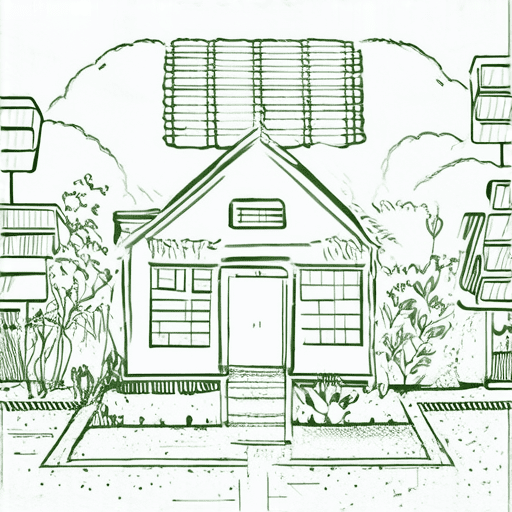As people increasingly seek ways to reduce their environmental footprint and live more sustainably, the concept of low-impact living has gained significant traction. This approach to daily life involves making conscious choices to minimize one’s impact on the planet, from reducing energy consumption and waste to adopting eco-friendly habits and practices. By embracing a low-impact lifestyle, individuals can significantly contribute to creating a more sustainable future for generations to come.

What is a Low Impact Lifestyle?
A low-impact lifestyle involves making conscious choices to reduce our ecological footprint and live more sustainably.
-
Reducing Resource Consumption
We can start by reducing our energy consumption through simple actions like turning off lights, electronics, and taps when not in use.
- Switch to energy-efficient light bulbs and appliances
- Adjust your thermostat to use less energy for heating and cooling
- Use power strips to easily turn off multiple devices at once
-
Minimizing Waste Generation
Another crucial aspect of a low-impact lifestyle is minimizing waste generation.
- Reduce single-use plastics by opting for reusable bags, water bottles, and straws
- Compost food waste and recycle paper, plastic, and glass
- Buy in bulk and choose products with minimal packaging
-
Greenhouse Gas Emissions Reduction
We can also reduce our carbon footprint by making changes to our transportation habits and diet.
- Cycle, walk, or use public transport for shorter trips
- Eat a plant-based diet and choose locally sourced food
- Offset flights and other long-distance travel
Practical Tips for Adopting a Low-Impact Lifestyle
At Eco Planeta Verde, we believe that every small change counts, and here are some practical tips to get you started:
- Explore our sustainable living tips
- Start a garden or join a community garden to grow your own fruits and vegetables
- Invest in a reusable coffee cup and shopping bag
- Support local businesses and artisans who share your values
Join the Movement towards a More Sustainable Future
By embracing a low-impact lifestyle, we can work together to create a more sustainable future for ourselves and generations to come.
Visit Eco Planeta Verde for more resources and inspiration on sustainable living.
Low Impact Development Examples
We’re committed to sharing knowledge on sustainable living practices, and today we’ll discuss Low Impact Development (LID). As a platform dedicated to eco-friendly solutions, we believe in empowering individuals to make informed decisions about their environment.
-
Rain Gardens
-
Bioswales
-
Pervious Pavement
-
Green Roofs
-
Wetlands Restoration
A rain garden is a shallow depression in the ground that collects and filters stormwater runoff. By incorporating native plants and a permeable surface, rain gardens reduce the amount of pollutants entering nearby waterways.
Bioswales are vegetated channels designed to manage stormwater runoff. They work by slowing down water flow, allowing sediments and pollutants to settle before reaching nearby water bodies.
Pervious pavement allows stormwater to percolate through its surface, reducing the amount of runoff that enters drainage systems. This type of pavement is often made from porous materials like concrete or asphalt.
Green roofs feature vegetation and soil on top of buildings, reducing stormwater runoff and providing insulation. These roofs can be intensive, with deep soil layers and large plant species, or extensive, with shallow soil and succulent plants.
Restoring wetlands involves rehabilitating degraded or destroyed ecosystems. Wetlands play a crucial role in filtering pollutants and storing carbon, making restoration efforts essential for maintaining ecosystem health.
At Eco Planeta Verde, we strive to educate our audience on the importance of sustainable practices. By implementing these LID techniques, individuals can contribute to a healthier environment and mitigate the effects of climate change.
For more information on sustainable living practices, visit our Sustainable Living page.
Learn how to adopt greener habits and make mindful decisions for a more sustainable future by exploring our Green Habits guide.
Discover the benefits of rain gardens and bioswales by reading our Rain Gardens and Bioswales article.

What Does Low Impact Include?
Low impact exercises are activities that involve minimal stress on joints and muscles, often characterized by slow and gentle movements.
- Walking: A low impact activity that can be done almost anywhere, walking is an excellent way to get some exercise while minimizing strain on joints.
- Yoga: A low impact exercise that combines physical movement with deep breathing and meditation techniques, yoga is great for flexibility and balance.
- Pilates: A low impact form of exercise that focuses on core strength, flexibility, and body control, Pilates is ideal for those who want to improve their posture and overall fitness.
- Swimming: A low impact aquatic activity that provides a full-body workout without putting excessive strain on joints, swimming is perfect for people with mobility issues or chronic pain.
- Skating: A low impact winter sport that involves gliding on ice or snow, skating is a fun way to stay active while minimizing joint stress.
- Cross-country Skiing: A low impact winter activity that involves traversing through snowy terrain, cross-country skiing is an excellent way to improve cardiovascular health and burn calories.
- Golf: A low impact outdoor activity that requires precision and strategy, golf is a great way to stay active while enjoying nature.
In addition to these popular forms of low impact exercise, there are many other activities that can be adapted to suit individual needs and preferences.
- Bodyweight Exercises: Squats, lunges, push-ups, and other bodyweight exercises can be modified to reduce impact and make them suitable for low impact workouts.
- Resistance Band Exercises: Using resistance bands can provide a low impact alternative to traditional weights and machines.
- Low-Impact Aerobics: Dancing, step aerobics, and other low-impact aerobic exercises can be modified to reduce impact and make them suitable for individuals with joint issues.
When incorporating low impact exercises into your routine, remember to start slowly and gradually increase intensity and duration as your body adapts.
Consult with a healthcare professional before beginning any new exercise program, especially if you have any underlying medical conditions or concerns.

What is Low Impact Housing?
As someone who values sustainability and reducing our carbon footprint, I’m excited to share my knowledge on low impact housing.
- Definition: Low impact housing refers to building designs and construction methods that minimize harm to the environment and reduce the strain on local ecosystems.
- Key Principles: These homes often incorporate features such as rainwater harvesting, grey water systems, composting toilets, and energy-efficient appliances.
Benefits of Low Impact Housing
- Environmental Benefits: By reducing waste, conserving resources, and minimizing pollution, low impact housing helps protect the environment and preserve natural habitats.
- Economic Benefits: These homes often require less maintenance and energy consumption, resulting in lower utility bills and increased property values.
- Social Benefits: Low impact housing promotes community engagement, education, and awareness about sustainable living practices.
Design and Construction Techniques
- Passive Solar Design: Homes are oriented to maximize natural light and heat, reducing the need for artificial lighting and heating/cooling systems.
- Recycled Materials: Builders use reclaimed wood, recycled glass, and other sustainable materials to minimize waste and reduce the demand on virgin resources.
- Green Roofs: Vegetated roofs provide insulation, reduce stormwater runoff, and create habitats for local wildlife.
Examples of Low Impact Housing
- Tiny Houses: Compact, efficient dwellings that promote minimalism and reduce waste.
- Earthships: Sustainable homes built into hillsides using natural and recycled materials.
- Straw Bale Houses: Insulated homes made from bales of straw, providing excellent thermal mass and reduced energy consumption.
Getting Started with Low Impact Housing
- Research and Education: Learn about sustainable building practices, local regulations, and available resources.
- Assess Your Site: Evaluate your property’s climate, soil conditions, and natural resources to determine the best low impact housing options.
- Consult Professionals: Work with architects, builders, and contractors experienced in sustainable building practices.
By embracing low impact housing principles, we can create healthier, more resilient communities that thrive for generations to come.
Is Low-Income Housing Safe?
As someone who cares deeply about sustainable living and reducing our carbon footprint, I’m often asked whether low-income housing is safe.
- Research suggests that affordable housing can actually have a positive impact on crime rates in neighborhoods.
- A 2022 study found that communities with affordable housing options tend to have lower crime rates compared to those without.
The Benefits of Affordable Housing
When done correctly, affordable housing can bring numerous benefits to both residents and the surrounding community.
- Increased sense of community: By providing affordable housing options, we can foster a stronger sense of community among residents, which can lead to increased social cohesion and reduced crime rates.
- Economic growth: Affordable housing can stimulate local economies by attracting businesses and investments to the area.
- Improved health outcomes: Access to affordable housing has been shown to positively impact mental and physical health, particularly for vulnerable populations such as low-income families and seniors.
Addressing Safety Concerns
While affordable housing can have numerous benefits, safety concerns are still a valid concern for many people.
- Security measures: Implementing robust security measures, such as CCTV cameras, secure entry systems, and on-site staff, can significantly reduce the risk of crime and ensure resident safety.
- Community engagement: Encouraging community engagement and participation in decision-making processes can help build trust between residents, developers, and local authorities, ultimately leading to safer and more inclusive communities.
Conclusion
In conclusion, low-income housing can be a safe and beneficial option for residents and the surrounding community when implemented correctly.
By prioritizing security measures, community engagement, and economic growth, we can create thriving and sustainable communities that benefit everyone involved.

Example of a Low Impact Building
A low impact building is designed to minimize its ecological footprint, often incorporating sustainable materials, energy-efficient systems, and innovative architectural features.
-
Passive House Standard
The Passive House standard is a widely recognized benchmark for low impact buildings, emphasizing airtight construction, super-insulation, and mechanical ventilation.
- Heating requirements reduced by up to 90%
- Energy consumption minimized through optimized insulation and air-tightness
- Mechanical ventilation systems provide fresh air and reduce moisture buildup
-
Eco-Friendly Materials
Sustainable materials play a crucial role in reducing the environmental impact of a building, from locally sourced wood to recycled materials.
- Bamboo and reclaimed wood offer durable, low-maintenance alternatives to traditional building materials
- Recycled materials reduce waste and conserve natural resources
- Locally sourced materials minimize transportation emissions and support local economies
-
Green Roofs and Walls
Green roofs and walls provide insulation, reduce stormwater runoff, and create habitats for urban wildlife.
- Plant species selection tailored to local climate and soil conditions
- Regular maintenance ensures optimal plant health and structural integrity
- Green roofs and walls can increase property values and enhance occupant well-being
By incorporating these features, low impact buildings can significantly reduce their environmental footprint, promote occupant health and well-being, and contribute to a more sustainable built environment.

0 Comments